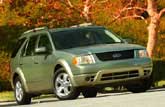Recent Articles
Popular Makes
Body Types
2005 Ford Freestyle Road Test
Almost Perfect
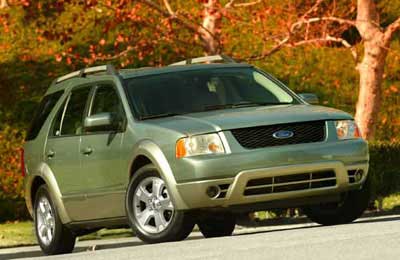
IRVINE, Calif. - Elvis Presley died from a lethal mix of prescription drugs on August 16, 1977. When the news broke I was riding in the cargo area of a forest-green 1972 Ford Galaxie 500 station wagon traveling 70 mph on southbound Interstate 75 in Michigan's lower peninsula, making out with the daughter of family friends with whom I had shared a tenth birthday four days earlier. Crackling over the Galaxie's AM band and through tinny speakers, announcers doled out the bits and pieces of information emerging from Graceland throughout our trip home from the family cabin in "da yoo-pee." Our mothers, sock-hop participants and enormous Elvis fans as high-schoolers, sat aghast at the news upon the Galaxie's green vinyl front bench seat, weeping at times as they reminisced about one of rock-and-roll's pioneering icons. Three decades ago, there was a station wagon parked in just about every suburban American driveway.a. Even my Elvis-loving mom had a burnt-orange 1973 Ford Gran Torino Country Squire named Betsy, complete with fake wood on the sides, a "sport" three-spoke steering wheel, a rear-facing third-row jump seat that folded down into the floor, and something she referred to as a "big whomping 351" every time she floored the accelerator to give her car-addled son a thrill. But then, in 1983, Chrysler Corporation signed a death warrant for wagons when it introduced the minivan. Minivan popularity lasted 10 years. Once the Ford Explorer successfully delivered rugged looks combined with four-wheel-drive and space for five, the minivan became forever tainted by a mommy-mobile image. Minivans were not cool, and later, at the end of the 1990s and into the 21st century, they were neither phat nor sick, though people did line up to buy the Honda Odyssey at prices above sticker. This anomaly aside, during the Internet boom and bust years, the sport-utility vehicle, or SUV, became the family conveyance of choice. Meanwhile, wagons began to stage a comeback, starting with European luxury brands, and SUVs became more like cars and less like trucks thus creating the crossover vehicle. Culminating the crossover trend, Chrysler introduced the 2004 Pacifica as a "sports tourer," a vehicle blending the best attributes of a sedan, an SUV, and a minivan into one do-it-all kind of vehicle. Ford's new Freestyle is that kind of vehicle, too, but better in most respects. Targeting consumers who want the comfort and ride quality of a sedan, the people- and cargo-carrying capacity of a minivan, the rugged look of an SUV, and all-wheel-drive to get them through difficult driving situations, the Freestyle is a modern take on the Ford station wagons of my youth - the ultimate family car.
Powertrain
Dubbed the Duratec 30, the Ford Freestyle's engine is an updated and more refined version of the Duratec 3.0-liter V6 that has been powering the Taurus since 1996, modified in this application to reduce noise, vibration, and harshness while simultaneously cutting emissions. On paper, the 2005 Ford Freestyle's 3.0-liter V6 engine appears to be the weakest part of the equation, making as it does a paltry 203 horsepower and 207 lb.-ft. of torque to motivate an unloaded curb weight of two tons, give or take a few pounds. In practice, however, the Freestyle is more energetic than expected. Credit the standard continuously variable transmission (CVT) for the Freestyle's ability to make the most of meager power. A CVT is essentially a small pulley and a large pulley joined together by a belt or chain to create an infinite number of gear ratios. This infinite number of gear ratios effectively keeps the engine within its optimum torque band, improving response when the driver depresses the accelerator. Another benefit of a CVT over a traditional automatic transmission is enhanced fuel economy, and Ford's CVT includes software that can recognize when the vehicle is traveling downhill and can maintain a steady speed to reduce the need to apply the brakes. An optional all-wheel-drive system improves the Freestyle's foul-weather traction. Essentially identical to an electronically controlled Haldex limited-slip coupling used by Volvo, the AWD system can transfer up to 100-percent of the engine's power to the rear wheels when the front wheels slip. A standard traction control system further distributes power to the wheel with greatest traction at each axle. If, after a test drive, you feel that the Duratec 30 doesn't make enough power, wait a couple of years. Ford plans to install a new 3.5-liter V6 under the Freestyle's hood for 2007, and that engine should be making in excess of 250 horsepower when it arrives.
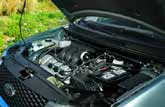
Model Mix
Ford sells the 2005 Freestyle in three trim levels with either front-wheel or all-wheel-drive. The standard Freestyle SE has 17-inch painted seven-spoke wheels, body-color grille surround, and dark gray door handles. Inside, the Freestyle SE is equipped with fake carbon fiber trim, a handy conversation mirror that allows the driver to see all occupants in the rear seats (Big Brother for parents), and a six-way power adjustable driver's seat. The Freestyle SE also includes a tilt steering wheel, one-touch up and down for the driver's window, power door locks with remote keyless entry, air conditioning, a CD player, and cruise control. Stepping up to the 2005 Ford Freestyle SEL adds dual-zone climate control, a trip computer, leather trim for the steering wheel and shift knob, a premium sound system, steering wheel stereo controls, automatic headlights, fog lights, a chrome grille surround, body-color door handles, and polished alloy wheels. Ford Freestyle Limiteds have a monochrome exterior décor with unique 18-inch eight-spoke alloy wheels and heated outside mirrors. Fake burled wood trim, tinted red with gray interiors and light brown with tan interiors, combines with perforated leather upholstery for an upscale appearance inside. Additional Limited equipment includes an Audiophile sound system with a six-disc in-dash CD changer, heated front seats, an eight-way power driver's seat, and a four-way power passenger's seat. Options for the Freestyle include all-wheel drive, power-adjustable pedals, rear climate control, a rear-seat DVD entertainment system, a reverse sensing system, and side-impact airbags with rollover protection. Freestyle SEL and Limited can be equipped with a power sunroof, while Limited models are available with a memory feature for the seats, pedals and exterior mirrors. We test drove a 2005 Ford Freestyle SEL, equipped with front-wheel-drive, power adjustable pedals, and Ford's Safety Canopy system of side-impact and side-curtain airbags with rollover protection.
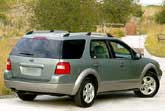
Comfort
Given the 2005 Ford Freestyle's meager 2,000-pound maximum tow rating, it's clear that this vehicle is designed to move people and not personal effects. In fact, Ford placed a high priority on occupant comfort, using a variety of computer technologies that enabled engineers to virtually sit in the seats and use the controls as a tall or short, fat or skinny, young or old, strong or weak person, and to ensure that the Freestyle would be effortless to live with for everyone. Even pregnancy suits, so realistic that they put pressure on engineers' bladders, were used in the quest for an easy-to-own vehicle. Upon sliding behind the wheel, which is simple since the hip-point (H-point) height of the seats makes entry effortless, it is clear that this attention to design detail has paid off. The front seats are soft yet supportive, wide and covered with a plush and durable cloth or optional leather, with a seating position that is tall and upright. Soft material coats the top of the door panels, making it a comfortable spot to rest an arm or elbow. Controls are designed for optimum ease of use by a variety of people. For example, two stalks are affixed to the steering column to control the lights and wipers, rather than the single stalk Ford has traditionally employed. Likewise, the stereo is designed around the use of the radio pre-set buttons, resulting in a simple, symmetrical layout that lacks only a tuning knob. The 2005 Ford Freestyle seats seven adults, though the two positions in the third row are good for little more than a cross-state jaunt if the occupants are six-feet or taller. Ford's claim that the Freestyle offers real leg and foot room for adults is accurate - this crossover's third-row is easily as comfortable as those in the smaller minivans on the market. Nonetheless, space is tight; trips with adults should be short despite the high, firm, but flat bench seat. Thanks to handy fold-and-flip second-row seats that can be operated with one hand, it's impressively easy to clamber into the rearmost seats of the Freestyle. Second-row seating is either a 60/40 split bench or individually reclining captain's chairs, the latter of which are mounted to tracks for fore and aft seat travel. Again, legroom is at a premium if tall people are occupying the front buckets, but the seats are firm, supportive, and sit high, affording excellent support and an impressive view out. Plus, foot room under the front chairs seems almost limitless. Be careful, however, when opening the rear doors. They can swing wide, and they have a sharp point where the door cuts in over the wheel well, which could easily ding the vehicle parked in the next space. Also, because the second-row seats are mounted well forward of the trailing edge of the rear door, entering and exiting in tight quarters is likely to require minor contortion for larger people. Regardless to which row of seats you've been assigned, the 2005 Ford Freestyle is a comfortable vehicle. We thoroughly enjoyed living with it for a week, so much so that we didn't really want to give it back, and that doesn't happen often.
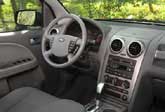
Cargo
Not only is the 2005 Ford Freestyle among the more comfortable family vehicles on the market, it also boasts impressive utility. Equipped with a solid rear seatback or a 50/50 split, the third-row seat folds into the floor to create a flat load surface. When the seat is raised, a deep well can swallow a surprising amount of cargo, and handy hooks keep plastic grocery bags from rolling about. A huge center console storage bin with cupholders divides the second row when it is equipped with captain's chairs. When the seats are folded to maximize cargo capacity, the top four inches of this console protrudes from the otherwise flat cargo floor, creating an impediment when trying to slide long, heavy items in through the tailgate. Making up for this oversight, to some degree, is a front passenger's seat that also folds in half to provide up to 9.5 feet of length between the dashboard and the closed tailgate. However, if your plan is to use the Freestyle to haul long, wide, heavy loads, we recommend sticking with the split-folding bench seat. Loading cargo can be hampered in other ways, too. The floor of the well behind the third-row seat is much lower than the mid-thigh liftover height, so sliding heavy objects into and out of the well is difficult. Flipping and folding the third-row seat is a two-handed operation, and when all the seats are folded flat, the resulting cargo floor has sizable gaps through which small items could be lost. Finally, Ford provides neither a tailgate release button on the remote key fob nor a flip-up rear window, and closing the tailgate is somewhat daunting since the provided recess is difficult to grip. Large center cupholders accommodate a variety of beverage containers, and the Freestyle boasts a total of 12 cup and bottle holders distributed throughout the cabin. Up front, a large center storage bin with a power outlet and a power cord cutout is sized to swallow a laptop computer if necessary; while a covered and rubber-lined storage bin atop the dash is perfect for items that won't melt in the sun. The overhead console includes storage for sunglasses and a remote control; while four large door pockets with integrated bottle holders handle a variety of items. Other storage spots include an illuminated glovebox; front seatback pockets; four cargo tie-downs; and an optional cargo net. Thanks to this plethora of cargo and storage solutions inside the Ford Freestyle, living with this vehicle is extremely easy.
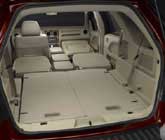
Safety
Ford says, "Freestyle starts with the notion that nothing is more important in a family vehicle than safety." The Freestyle's roster of safety technologies, combined with first-round crash testing by the NHTSA, confirms that the company put a high priority on occupant protection. It starts with the Freestyle's underlying structure, which is based upon Volvo's flagship S80 sedan and incorporates many Volvo safety innovations. (Volvo is owned by Ford Motor Company.) An energy channeling, "tripod" vehicle architecture routes crash forces around the passenger compartment, like in the Volvo S80. The Freestyle also includes elements of Volvo's Side Impact Protection System (SIPS), in this case a cross-car beam that deflects side crash forces under the seats. Additional Volvo methods used to provide safety include an horizontally-collapsing steering column that folds at two speeds depending on whether the driver is buckled or not, a roof brace connecting the B-pillars that absorbs side impact and rollover crash forces, and a collapsible driveshaft designed to channel force under and to the rear of the car. Furthermore, in anticipation of meeting future crash standards, the Freestyle's rear architecture has been designed to withstand a 55-mph impact, and according to Ford the third-row seat is farther away from the tailgate than any competing model. Finally, it seems Ford learned a lesson with the Pinto debacle of the 1970s; the Freestyle's fuel tank is placed forward of the rear axle, well away from the back of the vehicle. Standard equipment includes Ford's Personal Safety System of dual-stage, passenger-sensing front airbags, three-point seatbelts in all seating positions, adjustable head restraints in all seating positions, and front seatbelts equipped with pretensioners and load limiting retractors. The Freestyle's front airbags even take the driver's seat position into account when deploying in an effort to better protect shorter stature occupants. People with LATCH-equipped child seats will find the proper anchors installed in both the second- and third-row seats. Optionally available is Ford's Safety Canopy System. The Safety Canopy System includes side-impact airbags and side-curtain airbags with rollover protection. In a rollover accident, the Freestyle's side-curtain airbags remain inflated for an extended period of time to better protect occupants. Another useful safety option is the reverse sensing system, which beeps when it detects objects, such as children, that might be behind the Freestyle and out of view. In testing performed by the NHTSA, the 2005 Ford Freestyle received five-star ratings for frontal and side-impact crashes, the best possible score. At this writing, the NHTSA has not yet rated the Freestyle for rollover tendency, and the Insurance Institute for Highway Safety (IIHS) has not performed its regimen of 40-mph offset frontal, 32-mph side-impact, and new rear-impact crash tests.
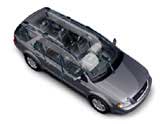
Quality
In a bid to boost craftsmanship and appearance, Ford engineers worked hard to ensure that the Freestyle's cabin exhibits proper graining for the plastic trim, and uniform coloration between panels. The use of soft-touch paints and metal plating on key controls helps contribute to an upscale, quality interface for the owner. The end result, despite the hard plastic dashboard, is a success. The Freestyle isn't a luxury car inside, but neither is it a penalty box. The quality of the interior materials meets the expectation set by the sticker price. Assembly quality is also quite good…on the inside of the Freestyle. This is a quiet car mostly free of wind, road, and mechanical noise at normal driving speeds, and it's this quietude that revealed a handful of squeaks and rattles in our test vehicle. A few dashboard pieces didn't line up straight, and the plastic glove box door lid was slightly warped, but otherwise the Freestyle proved to be tightly constructed. On the outside, Ford has some work to do with regard to getting the parts pieced together as tightly as Asian manufacturers. Our test sample exhibited several exterior misalignments, gap inconsistencies, and loose items of trim. Plus, the rubber moldings around the windows were already discolored after just a few thousand miles.

Hardware
Based on the Volvo S80's structure, the 2005 Ford Freestyle shares its platform and powertrains with the Ford Five-Hundred and Mercury Montego sedans. A Volvo-based MacPherson strut front suspension and a compact independent rear suspension with coil-over rear shocks feature almost four inches of suspension travel, which has allowed engineers the luxury of tuning the dampers for optimum ride quality and wheel control. Every 2005 Ford Freestyle includes four-wheel-disc antilock brakes with Electronic Brake-force Distribution (EBD). The brake pads are crafted with low-metallic materials that boast a high degree of friction, and Ford says that the result is reassuring stopping performance without excessive build-up of brake dust on the wheels. It works, thanks in part to twin-piston front calipers that afford quicker pedal response and more precise control of braking application. Standard 17-inch wheels allow the use of larger rotors with greater brake surface, too, helping to ensure the shortest stopping distances possible. Ford installs P215/65R17 Continental tires on the Freestyle SE and SEL, while the Limited receives P225/60R18 Pirellis to help improve steering feel and provide a sportier ride quality. Ford also knows that drivers want a vehicle that is responsive to input at the steering wheel yet easy to park thanks to light effort required at the steering wheel. The Freestyle is both: easy to park and responsive at speed. However, the turning circle proved to be wider than expected during U-turns.
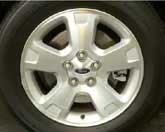
Driving
Critics claim that the 2005 Ford Freestyle is underpowered. An argument could be made to support that theory. A 203-horsepower V6 charged with motivating a seven-passenger vehicle that weighs two tons would indicate, on paper, that the Freestyle is a lethargic slug barely able to maneuver out of its own way. With one or two people aboard, the way most people commute most of the time, power is simply not an issue. Though the engine proves merely adequate, the Freestyle's CVT does a decent job of keeping the motor within the thick of its powerband. Our biggest complaint is that when accelerating from a standstill, it takes a moment for the engine to motivate the Freestyle. When the Freestyle is loaded with passengers, however, the 3.0-liter V6 becomes overwhelmed, especially during hill climbs. That's a shame, because the Ford Freestyle is otherwise so perfectly suited to serving as the ultimate do-it-all family vehicle. The new 3.5-liter V6 that Ford is readying for production cannot arrive soon enough. Otherwise, we can complain very little about the comfortable and competent 2005 Ford Freestyle. The brakes are extremely effective with terrific pedal feel, the steering is linear and responsive, the ride taut but composed. The Freestyle is not a sporting machine, and the handling falls apart pretty quickly when the car is pushed hard, but at the speeds that most people travel it's nimble, easy to park thanks to excellent outward visibility, and filters harsh road imperfections from the cabin with ease.

Wrap-up
After a week of commuting, shopping for furniture, and touring the Southern California countryside, we discovered that the 2005 Ford Freestyle is a wonderful machine to live with on a daily basis. It might not be terribly exciting to drive, its bodywork might not inspire lust, but it is an absolute pleasure to use and it includes a comprehensive package of safety equipment. And though Ford may be reticent to call it a station wagon, that's exactly what it is - a contemporary rendition of the ultimate family cars of the 1960s and 1970s. Thirty years of evolution has resulted in higher seating positions with a commanding view out, a third-row seat made for adults and facing forward rather than to the rear, and primary drive wheels that have swapped ends. Plus, there's all-wheel-drive, greatly improved safety systems, and styling that doesn't look exactly like a sedan from the front doors forward. However, nobody's mom is gonna refer to the "big whomping Duratec 30" under the Ford Freestyle's hood, that's for sure.
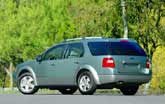
Specifications
Test Vehicle: 2005 Ford Freestyle SEL Engine Size and Type: 3.0-liter V6 Engine Horsepower: 203 at 5,750 rpm Engine Torque: 207 lb.-ft. at 4,500 rpm EPA Fuel Economy: 20 city and 27 highway Observed Fuel Economy: 19.3 mpg Curb Weight: 3,959 lbs. Max. Cargo Capacity: 86.5 cubic feet Max. Towing Capacity: 2,000 lbs. Max. Seating Capacity: 7 Competitors: Buick Rendezvous, Buick Terraza, Chevrolet Uplander, Chrysler Pacifica, Honda Pilot, Pontiac Montana SV6, Saturn Relay, Toyota Highlander
